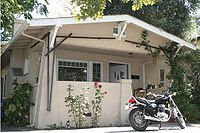



![The majority of Chicago Bungalows were built between 1910 and 1940. They were typically constructed from brick (sometimes in decorative patterns) and had one and a half stories. At one point, nearly a third of the houses in the Chicago area were bungalows. One primary difference between the Chicago bungalow and other types is that the gables are parallel to the street, rather than perpendicular. Like many other local homes, Chicago bungalows are relatively narrow, [3] being an average of 20 feet (6.1 m) wide on a standard 25-foot (7.6 m) wide city lot.](https://blogger.googleusercontent.com/img/b/R29vZ2xl/AVvXsEhxNPnLg1rPTqM-Q8xAds0a113P6aZ0_i7wS4Zs_oSqDo5ZZQU8iEoPn-0mHSJT04wEW_lpodcfFAtB1vyHeGQGJiBp_j4msK4oN6NILMgSKkdI2T-DAZUlDGUkBa1w0H-Xgy8Xv5WAon4/s320/180px-Summer_2006_0882.jpg)




Bungalows are very convenient for the homeowner in that all living areas are on a single storey and there are no stairs between living areas. A bungalow is well suited to those who are mobility impaired, e.g. the elderly or those in wheelchairs.
Neighborhoods of only bungalows offer more privacy than similar neighborhoods with two-story houses. With bungalows, strategically planted trees and shrubs are usually sufficient to block the view of neighbors. With two-story houses, the extra height requires much taller trees to accomplish the same, and it may not be practical to place such tall trees close to the house to obscure the view from the second floor of the next door neighbor. On the other hand, even closely spaced bungalows make for quite low density neighborhoods, contributing to urban sprawl.












No comments:
Post a Comment